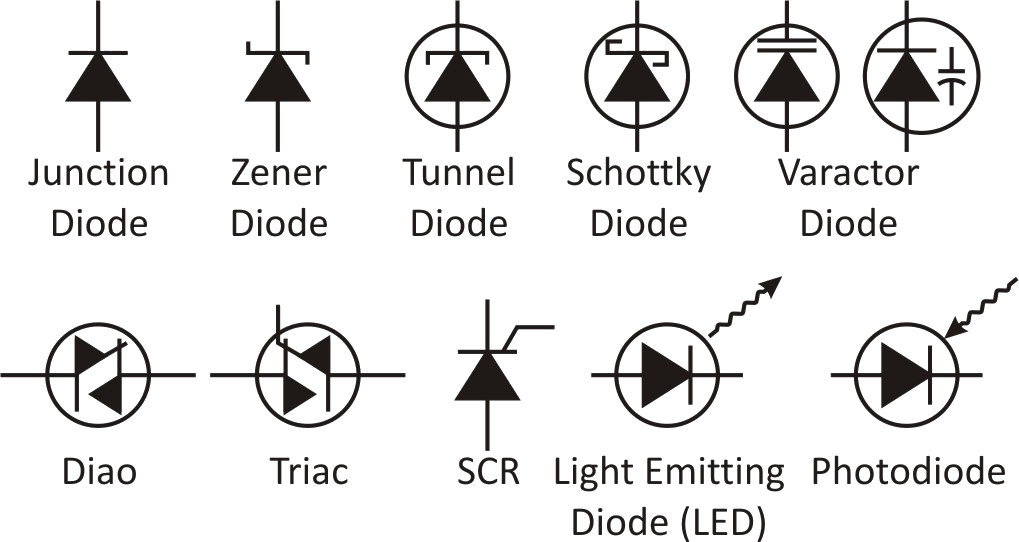
Give circuit symbol of diode.
Answer
564.9k+ views
Hint: The arrowhead represents the p-type semiconductor and the vertical bar represents the n-type semiconductor. The arrow represents the direction of conventional electric current through the diode.
Complete step by step answer:The semiconductor diode is a widely used electronics component found in many electronic circuit designs today. A two electrode device is called a diode. A diode allows unidirectional flow of current and it restrains the flow in the opposite direction.
Although there are many different types of diodes which use the same basic structure of an area of p-type material meeting an area of n-type material, the different types are optimized to provide different characteristics which can be used in a variety of ways in many electronic circuit designs.
The arrowhead represents the p-type semiconductor and the vertical bar represents the n-type semiconductor. The arrow represents the direction of conventional electric current through the diode.

Diodes have 2 electrodes namely : Anode and cathode. Anode is positively charged electrode and cathode is negatively charged electrode .
There are different types of diodes as :

Note:A diode allows unidirectional flow of current and it restrains the flow in the opposite direction.
A diode is a semiconductor device that essentially acts as a one-way switch for current. It allows current to flow easily in one direction, but severely restricts current from flowing in the opposite direction. Due to this unique quality of the diode it has different applications such as communication systems as limiters, clippers, gates; computer systems as logic gates, clampers; power supply systems as rectifiers and inverters; television systems as phase detectors, limiters, clampers; radar circuits as gain control circuits, parameter amplifiers
Complete step by step answer:The semiconductor diode is a widely used electronics component found in many electronic circuit designs today. A two electrode device is called a diode. A diode allows unidirectional flow of current and it restrains the flow in the opposite direction.
Although there are many different types of diodes which use the same basic structure of an area of p-type material meeting an area of n-type material, the different types are optimized to provide different characteristics which can be used in a variety of ways in many electronic circuit designs.
The arrowhead represents the p-type semiconductor and the vertical bar represents the n-type semiconductor. The arrow represents the direction of conventional electric current through the diode.

Diodes have 2 electrodes namely : Anode and cathode. Anode is positively charged electrode and cathode is negatively charged electrode .
There are different types of diodes as :

Note:A diode allows unidirectional flow of current and it restrains the flow in the opposite direction.
A diode is a semiconductor device that essentially acts as a one-way switch for current. It allows current to flow easily in one direction, but severely restricts current from flowing in the opposite direction. Due to this unique quality of the diode it has different applications such as communication systems as limiters, clippers, gates; computer systems as logic gates, clampers; power supply systems as rectifiers and inverters; television systems as phase detectors, limiters, clampers; radar circuits as gain control circuits, parameter amplifiers
Recently Updated Pages
Master Class 12 English: Engaging Questions & Answers for Success

Master Class 12 Business Studies: Engaging Questions & Answers for Success

Master Class 12 Economics: Engaging Questions & Answers for Success

Master Class 12 Social Science: Engaging Questions & Answers for Success

Master Class 12 Maths: Engaging Questions & Answers for Success

Master Class 12 Chemistry: Engaging Questions & Answers for Success

Trending doubts
What are the major means of transport Explain each class 12 social science CBSE

Which are the Top 10 Largest Countries of the World?

Draw a labelled sketch of the human eye class 12 physics CBSE

Explain sex determination in humans with line diag class 12 biology CBSE

The pH of the pancreatic juice is A 64 B 86 C 120 D class 12 biology CBSE

Explain sex determination in humans with the help of class 12 biology CBSE




